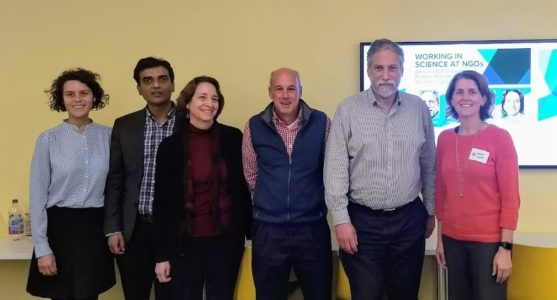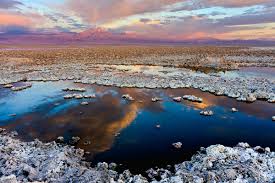EMPOWER’s Water-Energy seminar class took an informative guided tour of Syracuse Metropolitan Wastewater Treatment Plant (aka METRO) on January 25th, 2019. Expert guide, Senior Operator Mike Burkett, brought the class through all of the primary buildings on the campus and explained the city’s water treatment process start to finish.
EMPOWER Trainees Attend AGU conference
A dozen EMPOWER students attended the 100th annual American Geophysical Union (AGU) fall meeting December 9th through the 15th, 2018 in Washington D.C. The students attended keynote lectures by Lisa Jackson (VP Environment, Policy, and Social Initiatives, Apple) and James Balog (Founder and Director, Earth Vision Institute and Extreme Ice Survey), among others. Each day they also attended each other’s presentations (with 11 of them presenting at the conference) as well as supporting Syracuse University faculty presentations during the event. Three trainees: Amanda Campbell, Crystal Burgess and Emily Baker received AGU’s prestigious Outstanding Student Presentation Award for their work. As a group they participated in an Ecohydrology mixer targeted at young professionals seeking internship and employment opportunities. The mixer proved to be an excellent opportunity to network with individuals working in fields related to the Water-Energy nexus. They also arranged a group dinner following this event to share experiences and extend their networking. The group also welcomed two colleagues from the University of Rwanda who made the journey (their first to the U.S.) to present their work.



Framing the Debate on Climate Change
Written by: Nick Zaremba, Nimisha Thakur, Amanda Katherine Klaben and Connor Olson
Discussing climate change with skeptics and deniers can often seem pointless. It can be difficult to discuss the issue with someone who believes “the science behind climate change is weak or biased.” Such beliefs can lead to both parties talking over one another. These arguments about “weak science” or “climate change policy does more harm than good” are an attempt to persuade individuals by being relatable, this tactic is called framing. Framing can be used by any group not just climate deniers. For example it can be a very effective tool in furthering the discussion with a climate skeptic or denier to convince them of the severity of the issue. Recently EMPOWER students took part in a class discussion on how to better frame the conversation of climate change. Papers were discussed in which various frames were employed to convince an individual of the severity of climate change. These studies found that the local frame or stressing the effects that climate change will have on a certain regions is one of the most effective. The class then participated in an activity, utilizing the information provided by the paper, in which students developed frames to better inform a variety of individuals regarding the severity of climate change. The class was provided examples of individual cases including the reasons as to why the person did not think climate change was an issue or why they did not agree with policy that tried to mitigate climate change.
The discussion of framing was continued with a visit from Dr. Leigh Raymond, a professor of Political Science at Purdue University. Dr. Raymonds’ research focuses on how social norms or conceptions often affect environmental policy. EMPOWER students who attended lunch with Dr. Raymond discussed some of his most recent research which involved talking with farmers about the economic benefits of certain farming techniques which are also more environmentally friendly. Dr. Raymond’s presentation, titled Reclaiming the Atmospheric Commons: Carbon Pricing in the U.S. and Canada, on how framing an argument is used in policy decisions such as cap and trade of carbon emissions discussed how certain tactics are employed by various groups using frames in order to change current social norms and in turn provide a more compelling arguments. Dr. Raymond stressed how important the framing of a policy issue can be in order to acquire public support for environmental policy. He provided support of this through case studies in the United States and Canada such as RGGI (Regional Greenhouse Gas Initiative) , the California dividend, and GreenON. By focusing on the need to change current social norms regarding Carbon Emissions, Dr. Raymond shifted the conversation and onus of climate policy provisions to all stakeholders of the environmental commons.
EMPOWER hosts Dr. Josh Henkin of STEM Career Services
In cooperation with the Graduate Office of Professional and Career Development, EMPOWER hosted Dr. Josh Henkin for two days of interactive seminars addressing a wide range of relevant professional development topics and skills. Dr. Henkin offered our trainees a uniquely credible perspective as a Ph.D. with direct experience as an industry hiring manager.
We began day one with “Strategic Career Planning” which provided much needed information to our STEM grads about assessing and cataloging their skills and preferences as a tool to plan their future career, use of social media, engaging a mentor along with valuable CV/resume tips.
The afternoon focused on branding. The “Elevator Pitch 2.0” workshop demonstrated how to frame one’s education, skills and experiences in way that best showcases them to potential employers. Students learned how to “tell a story,” with their CV/resume and in person during an interview or networking opportunity (and how to make those networking opportunities happen).
A classic Syracuse lake effect snowstorm on Thursday night/Friday morning did not slow us down! Friday morning’s workshop, “Writing a Cover Letter the Right Way” was a deep dive on searching for and then applying to jobs of interest. Josh explained when a cover letter is appropriate (or not) and how to best develop one that is suited to the job description. Trainees did hands on activities assessing multiple job descriptions – learning to pull pertinent details they could use to custom tailor their CV/resumes and cover letters when applying for a position.
A networking lunch and numerous one-on-one appointments between Josh and individual trainees preceded our final workshop for the day, “The Universe of STEM Careers Available to STEM Grads and the Communication Skills that Will Take You There.” This workshop addressed a critical knowledge gap regarding what types of careers STEM grads may consider upon graduation and provided tools to help students identify how their values, interests and skills align with potential careers of interest. The workshop also introduced trainees to “mind-mapping,” a technique used to create a list of expanded professional skills (technical and transferable) called “micro” skills. Participants agreed that the exercises made them more aware of their strengths and better able to articulate them to others.
Continental Rifting in East Africa
Written by: Micah Wiesner, Lachlan Wright, Shaidu Nuru Shaban
Natural release of CO2 from earths interior can be associated with volcanic degassing, or fault related sources. This natural release is hard to quantify due to large geographic variance and the lack of studies focusing on fault related release.
The East African Rift System, an 8 million year old continental rift system which stretches from Afar in the North to Mozambique in the South of Africa, provides a natural laboratory to study the release of CO2 from faults and volcanoes in close proximity. Calculations from this setting can be extrapolated to better constrain the global natural release of CO2 from the earth to the atmosphere.
James Muirhead, a Research Associate within the Department of Earth Science of Syracuse University has helped to address this question in a recent paper Massive and Prolonged Deep Carbon Emissions Associated with Continental Rifting published in the journal Nature (2016). By measuring the CO2 released across faults in the rift, Muirhead and other researchers were able to constrain the flux through time, and the source region of the CO2 within the earth. By comparing this to the CO2 released from the burning of fossil fuels, they were able to show that fossil fuels release approximately 500 times more CO2 than processes associated with rifting.
From Cradle to Grave: Investigating Urban Agriculture and Waste Streams
Written by: Julio Beltran, Laura Markley, Gaired Jordan, Joseph Wasswa & Shiru Wang
Are you charmed by the recent community garden that’s taken over the abandoned lot down the street or shocked that the new apartment complex downtown has hydroponic tomatoes growing on its roof? Community gardens and hydroponic systems are both forms of urban agriculture that may help greenify cities and provide locally-grown produce to city dwellers. Making cities more sustainable with urban agriculture has a multitude of benefits, but may have implications for energy consumption, water usage, and the food supply chain. EMPOWER students discussed urban agriculture’s role in the food system, which contributes to 15% of the total US energy demand. Students participated in a debate where they had to argue that their assigned urban agriculture systems, water supplies, and energy sources were the best choice for a model city.
Dr. Lut Raskin furthered the discussion by sharing her research on converting organic waste streams into sustainable resources with novel anaerobic bioprocesses in her AEESP distinguished lecture on November 9, 2018. In attendance were students from Syracuse University, Cornell University, as well as other colleges. Dr. Raskin discussed harnessing the power of microbial communities to treat water, recovering resources from waste streams, and modeling engineering systems after the stomach of a cow. She also furthered the conversation of research expectations and how obtaining results you hadn’t hoped for can still further the field.
These discussions provided a holistic perspective of urban agriculture and waste streams from a cradle to grave perspective.
Exploring Real World Impacts of Research at the Water-Energy Nexus
EMPOWER students and faculty traveled to Cornell University to attend the first in a series of workshops held at The Atkinson Center for a Sustainable Future this fall. “Science at an NGO” was presented in collaboration with the Center’s long-standing partner, the Environmental Defense Fund (EDF). The distinguished panel featured Chief Scientist (and EMPOWER External Advisor) Steve Hamburg along with Jennifer McPartland, Ritesh Gautam and Doria Gordon. SU Professor and EMPOWER faculty member Charles Driscoll introduced Dr. Hamburg. Each panelist discussed their career trajectories, what they are currently working on at EDF and the real-world impact of their research.

Exploring the Critical Role of Alpine Groundwater
Written by: Ruta Basijukaite, Nicholas LoRusso, Qasim Mehdi and JR Slosson.
Mountains are “the water towers of the world” explained the University of Calgary’s Dr. Masaki Hayashi to a full audience of EMPOWER trainees, faculty, and students at Heroy Geology Laboratory. Dr. Hayashi visited Syracuse University as part of the 2018 Darcy Lecture Series, which is supported by the Groundwater Foundation. The lecture capped off recent study by EMPOWER trainees in the realm of alpine hydrology to gain a better understanding of the role mountains play in global water supply.
Dr. Hayashi and EMPOWER trainees alike explored some of the pressures facing alpine water sources, such as a decline in glacial mass, smaller annual snowpack, and earlier spring snowmelt. EMPOWER trainees discussed how glacial meltwater helps buffer streamflow during low flow periods, particularly in the Andes Mountains and the Himalaya-Hindu Kush region. Dr. Hayashi built on this knowledge by exploring the important role of alpine groundwater in winter streamflow and its storage in rock glaciers and talus slopes through a discussion on his work in the Canadian Rockies. Trainees left with a better appreciation of how water moves through and is stored in these remote but beautiful environments.
Powering the Digital Transformation: Lithium Brines
Written by: Amanda Campbell, Courtney Nichols, Julianne Sweeney
Many of our modern handheld devices such as cell phones and laptop computers are powered by lithium batteries. Since they are easily recharged, lithium batteries are useful in the growing electric and hybrid vehicle market as well as for storing energy from solar panels. Most of the lithium we use comes from concentrated brines (salt water) and chances are high that it comes from a single source – the Salar de Atacama. This basin in the Andes Mountains has average lithium concentrations of 1,400 mg/L, ~14 times higher than Clayton Valley, Nevada, where the only U.S.-based lithium extraction operation exists. Scientists have found that lithium-rich brines only form in places that meet certain criteria: arid climate, a closed basin with a salt crust (salar) or lake, igneous or geothermal activity, tectonically driven subsidence, a lithium source, and time to concentrate the brine. These conditions allow lithium levels to rise several orders of magnitude higher than the amount of lithium in precipitation or rivers in the area. Yet, much remains to be learned about the mechanisms behind lithium brine formation.
Dr. David Boutt, from the University of Massachusetts at Amherst, is at the forefront of research on lithium brines. On September 20, 2018 he delivered the SU Earth Science Department’s Nelson seminar as the Geological Society of America (GSA) Birdsall-Dreiss Distinguished Lecturer. Dr. Boutt studies the conditions that make the Salar de Atacama the single largest source of lithium. As a hydrologist, he is especially interested in how much groundwater from outside the basin contributes to the lithium brine and where that water is coming from. In his talk, he discussed the lithium sources and how much of it is transported into the basin through groundwater. Although precipitation over the salar is low, it is much greater over the surrounding mountains and this water can carry the necessary amount of lithium to the salar, where it is concentrated by the very high evaporation rate. The naturally-occurring high concentration of lithium in this basin decreases the amount of time required by mining companies during the extraction and concentrating process, making it a valuable lithium source.
Despite increasing demand, current lithium resources are expected to meet future demand for many years, allowing the global population to continue transitioning towards renewable energy sources and a lower carbon footprint.

EMPOWER Trainees consider “The Shift”
Written By: Darci Pauser and Riley Sessanna
As global population grows and energy needs increase it is important to question where our energy comes from and at what cost.
In preparation to discuss these topics, EMPOWER students attended a screening of the documentary Switch, a 2012 film which explores how much energy an average person consumes and from where that energy is sourced. Following the screening, students had the opportunity to voice their opinions of the film and discuss the means of producing and consuming energy. Discussions led to topics on renewable versus non-renewable energy, what countries are doing to produce “clean energy,” and the most important sources of energy for various consumers.
The film prompted students to consider what it will take for humankind to make “the switch” to cleaner and more efficient energy production—a transformation that will allow us to power a world with a growing population, in addition to growing energy needs. Not only has gross energy consumption increased, but much of this consumption has shifted to developing nations, bringing to bear questions of equity for economic development and its necessary energy needs. Energy trade balances (exports minus imports of energy products), as well as energy intensity (the amount of energy used per unit of GDP) problematizes state-centric notions of energy production and consumption. In short, Switch made students think about the complexity involved in energy issues.
EMPOWER students then participated in a game of jeopardy, highlighting key points made in the movie and discussed in the seminar. Teams of students and professors worked to gain the highest score – the fastest buzzer reactions and the strongest knowledge on energy sources and consumption receiving top scores. Winners of the game each received the grand prize of an EMPOWER laser pointer, along with bragging rights until the next edition of Energy Jeopardy.